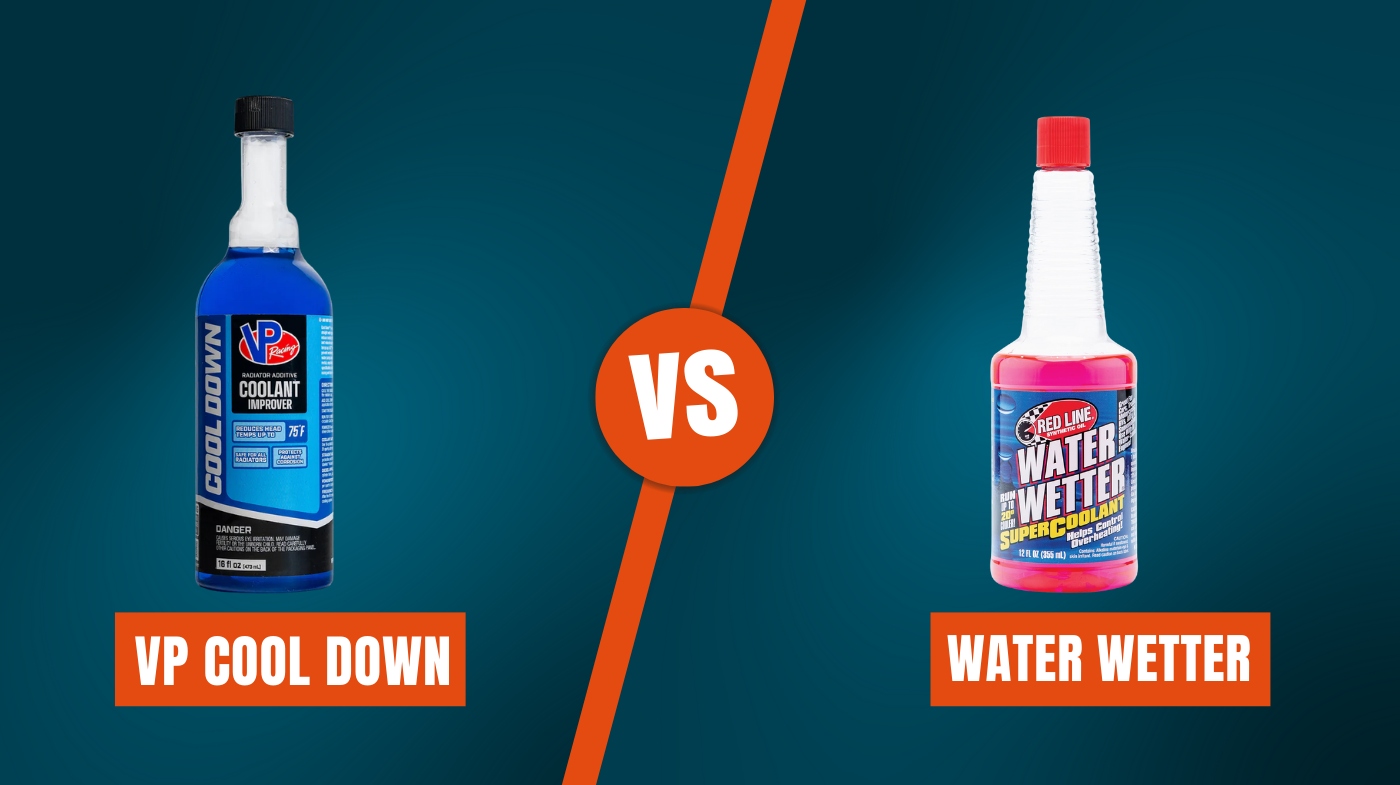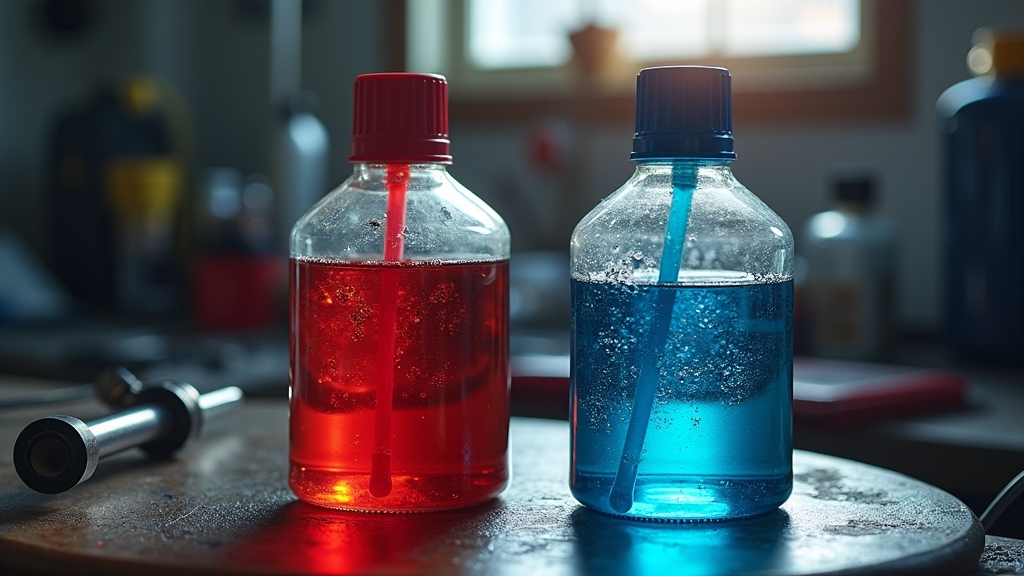Physical Address
304 North Cardinal St.
Dorchester Center, MA 02124
Physical Address
304 North Cardinal St.
Dorchester Center, MA 02124

If you want modest cooling gains with improved heat transfer in high-performance gasoline engines, VP Cool Down offers a cost-effective solution but lacks freeze and corrosion protection.
Water Wetter provides more consistent temperature reduction, better thermal conductivity, and broader engine compatibility, including marine and motorcycle applications, though at a higher price.
Both improve coolant wetting, but Water Wetter’s premium formula suits specialized needs. Understanding their differences can help you optimize your engine’s thermal management more precisely.
| Feature | VP Cool Down | Water Wetter |
|---|---|---|
| Cooling Performance | Up to 30°F reduction in high-heat conditions; modest in real tests | Up to 20°F reduction, consistent heat transfer improvement |
| Thermal Conductivity | Improves coolant wetting and heat transfer | Better thermal conductivity, enhances cooling efficiency |
| Corrosion Protection | Contains advanced corrosion inhibitors | Limited corrosion protection, mainly through improved heat transfer |
| Compatibility | Suited for high-performance gasoline & turbo diesel engines | Broad use: cars, motorcycles, marine engines |
| Freeze & Corrosion Protection | Lacks freeze protection; needs compatible coolant | No freeze protection; must be used with proper antifreeze |
| Additional Benefits | Lubricates seals and water pumps, prevents sludge | Primarily focuses on heat transfer without lubrication |
| Cost Efficiency | More fluid per bottle at lower price | Higher price per ounce but effective per treatment |
| Application | Best for extreme, high-load conditions | Preferred for consistent, everyday heat management |

Although VP Cool Down and Water Wetter both aim to lower engine temperatures, their actual cooling performance varies considerably depending on conditions and engine setup.
VP Cool Down claims up to 75°F reduction in cylinder head temperature and 30°F overall engine temperature drop, but controlled tests show more modest decreases around 3.8°F to 6°F. It also contains anti-foaming agents to ensure consistent coolant system performance, which is crucial for maintaining engine longevity similar to how engine oil additives protect engine components.
Water Wetter advertises up to 20°F reduction by enhancing heat transfer efficiency, with lab results supporting minor improvements between 3°F and 10°F.
Both additives improve coolant wetting and thermal conductivity, promoting better heat transfer rather than directly cooling.
You’ll find these benefits most evident under high-load or racing conditions, whereas everyday use yields limited temperature changes. Real-world users often says smaller gains than commercial claims suggest, highlighting the need for measured expectations.
Understanding how VP Cool Down and Water Wetter interact with different engine types helps you determine their suitability beyond just cooling performance.
VP Cool Down excels in high-performance gasoline engines, including turbocharged and naturally aspirated variants, effectively lowering cylinder head temperatures. Its formulation enables it to reduce surface tension, improving coolant flow and heat transfer in demanding conditions.
VP Cool Down effectively reduces cylinder head temperatures in high-performance gasoline engines, both turbocharged and naturally aspirated.
Water Wetter offers broader versatility, performing well in passenger cars, racing engines, motorcycles, and marine engines due to its compatibility with various materials and operating conditions.
Both additives support mixed-metal cooling systems without promoting galvanic corrosion when used correctly. VP Fuel Cool Down is often used as an additive to improve cooling efficiency, particularly in diesel engines with specific requirements such as high-mileage or modified engines, though its efficacy may be limited compared to some advertising claims cooling efficiency.
While VP Cool Down shows promise in turbocharged diesel engines like Cummins, formal validation is limited. Neither product suits air-cooled or waterless coolant systems.
Choosing between them depends on your engine configuration, cooling system type, and operating environment, aligning additive properties with your specific engine requirements.
When selecting an additive for your cooling system, you need to contemplate both the specific heat reduction capabilities and the operational context.
VP Cool Down excels in high-heat environments like racing engines, offering up to 50°F reduction claims, whereas Water Wetter typically achieves around 20°F under similar conditions. Dexos oil is known for its tailored additive packages to meet specific engine requirements, illustrating how specialized formulations can enhance performance.
However, both yield more modest improvements—5 to 14°F—in controlled tests. Notably, VP Racing Cool Down demonstrated effective heat transfer in tests with a boiling point similar to Peak antifreeze, enhancing temperature management heat transfer efficiency.
You should note that neither additive replaces proper coolant; they require precise mixing with water or coolant to avoid deposits or compatibility issues.
VP Cool Down lacks freeze and corrosion protection, limiting its use in cold climates without compatible coolants. Water Wetter’s broader application suits various water-cooled engines but demands caution to prevent reactions with standard coolants.
For street driving, temperature gains may be marginal, so evaluate cost-effectiveness accordingly. Understanding the performance under extreme conditions of additives can help in selecting the best product for your needs.
Beyond their temperature reduction capabilities, VP Cool Down and Water Wetter differ markedly in how they address corrosion protection and offer additional system benefits.
VP Cool Down contains advanced corrosion inhibitors that protect various metals and meets ASTM D3306 standards, reducing electrolysis and metallic ion loss. It also uses multiple wetting agents to enhance coolant contact, preventing localized hot spots.
Additionally, it is compatible with all radiator systems and coolants, ensuring broad usability across vehicle types. Its formulation also includes components that contribute to anti-wear protection, extending the lifespan of cooling system parts.
Conversely, Water Wetter lacks dedicated corrosion inhibitors and relies mainly on surface tension reduction to indirectly minimize corrosion via improved heat transfer.
Regarding additional benefits, VP Cool Down lowers component temperatures considerably, lubricates moving parts, prevents sludge formation, and maintains system efficiency across all coolant types.
Water Wetter primarily improves coolant wetting and heat dissipation, offering thermal benefits without comprehensive corrosion protection or lubrication properties.
You shouldn’t use VP Cool Down or Water Wetter in electric vehicle cooling systems. They lack the necessary dielectric properties and compatibility with EV materials, risking corrosion and electrical faults.
EV coolants require specialized formulations tested for thermal stability, low conductivity, and material compatibility.
Always follow manufacturer recommendations and use approved EV-specific coolants to guarantee safe, efficient thermal management and system longevity.
You won’t suddenly see your coolant turn neon after adding these additives—they’re clear or lightly tinted, so your radiator fluid’s color stays basically unchanged.
But don’t just pour leftovers down the drain; both VP Cool Down and Water Wetter contain chemicals requiring responsible disposal. Follow local hazardous waste rules and take unused or contaminated fluids to proper collection sites to avoid environmental harm.
Yes, you should add either additive directly into the radiator or coolant reservoir, following the manufacturer’s dosage—typically one 16 oz bottle per 12-20 quarts.
In extreme cold, maintain a minimum 40% glycol antifreeze mix to guarantee freeze protection and corrosion resistance. Avoid overdiluting with water, monitor pH levels, and replace coolant every two years.
Proper mixing ratios preserve freeze and boil-over protection while optimizing heat transfer in cold conditions.
Just like assembling a finely tuned orchestra, you can safely combine these additives with other engine performance enhancers. They focus on heat transfer and corrosion protection without conflicting with tuning or intake mods.
VP Cool Down even lubricates seals and water pumps, complementing high-stress scenarios. No warnings exist against mixing them with common boosters, so you can confidently integrate these additives to enhance engine durability and performance under demanding conditions.
You can expect VP Cool Down and Water Wetter to remain effective for about 2 to 3 years once opened, provided you store them properly. Keep their containers sealed tightly and away from heat, humidity, and sunlight to slow degradation.
Frequent exposure to air accelerates chemical breakdown, so minimize opening times. Always check for changes in color or odor, as these indicate diminished performance. Proper storage and handling preserve their cooling additive properties.
When choosing between VP Cool Down and Water Wetter, consider your engine type and cooling needs. For example, a performance tuner found VP Cool Down reduced temps by 10°F in a high-output V8, outperforming Water Wetter’s 6°F drop.
While both improve heat transfer and corrosion protection, VP Cool Down suits extreme conditions better. Ultimately, you’ll weigh cost against your engine’s demands, ensuring optimized cooling and longevity without unnecessary expense.
Last update on 2025-12-25 / Affiliate links / Images from Amazon Product Advertising API